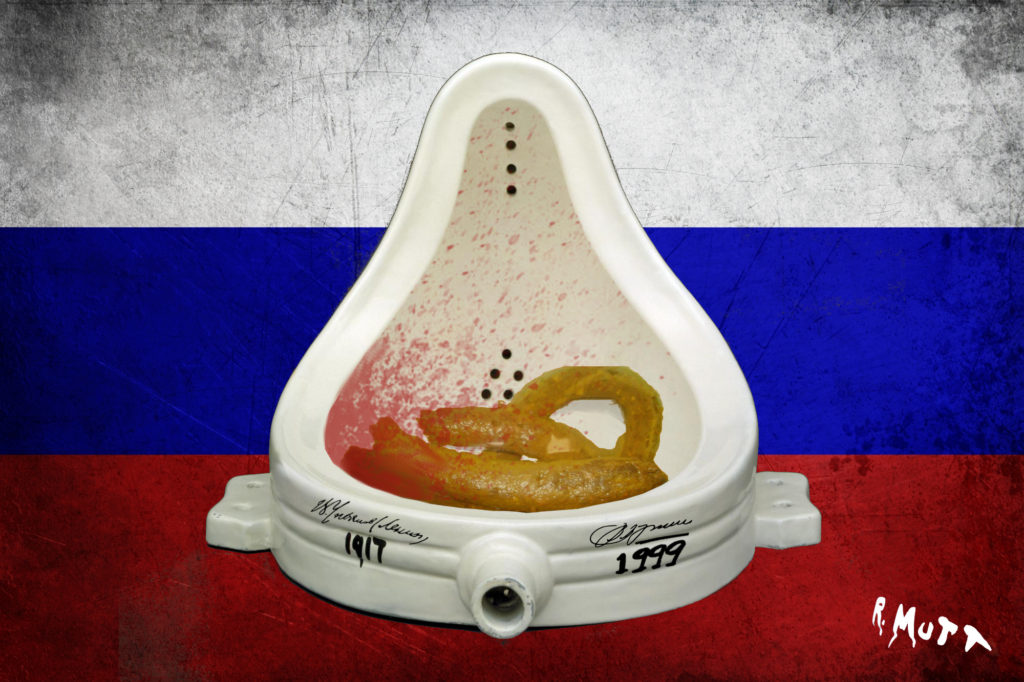In the spirit of the ‘easy solve’ for Steve Lazarides as Banksy (I’m sorry, it’s just so obvious), I hadn’t initially watched his interview from 2014 on RT, although I used it as an image in the story. Having watched it now, I think it is very informative for the “Art War“. In fact, the segment itself was literally dangled before commercial break as: “The Art of War – how Britain’s artists are taking politics to the street”.
Come learn from the impoverished historical perspective of Professor Banksy Lazarides (but made much better by a possible Monty Python reference).
‘Power as a political message’ – Steve Lazarides on the street art revolution; Oct 8 2014 – Going Underground – RT (full episode, clip below)
(Following a brief intro where the host introduces Lazarides as the man who popularized Banksy…)
[Going Underground host Afshin Rattansi] “So Steve – we are at war yet again”
{Steve Lazarides} “We are indeed”
[AR] “How is the kind of art you’ve been championing going to help us through this?”
{SL} “It’s interesting that you say that — if you look back to what was going on a few years ago with the Arab Spring…”
Lazarides dives off into a bit of a tangential historical example of anti-Roman graffiti as a method of political expression used by powerless/silenced people against authoritarian regimes. (In a sense, this is quite a bit like how conspiracy theory may be used by RT in order to subvert the dominant Western political narratives, or how prophecy has been used for political propaganda purposes too.)
“In its purest form, graffiti has been around for thousands of years — you know, ‘Romans Out!’ scrawled on the wall by someone…”
– Steve Lazarides
Lazarides then relates that historical example of oppressed subjects of Imperial Rome to graffiti from the Arab Spring in Tunisia and Bahrain. He and the host contrast views of graffiti as a method of effective political expression in the ‘East’ and ‘West’, with Afshin Rattansi suggesting that street art is seen by the “Daily Mails of this world as vandalism“.
(See below for Lazarides’ apparent historical influence from Monty Python… Unless the notion of ‘Romans Out!‘ as graffiti had come to him from racist, anti-Romanian vandalism reported in Northern Ireland during 2014, it doesn’t seem to be a proper historical example.)
Whatever the origin of his historical musings, Lazarides sees street art as representative of “groundswell“, “grassroots” kinds of populist movements which can grow so strong that they “topple[s] the government“, and can be “twisted in the ‘Daily Mail’s’ side of things“, but it definitely “resonates with the public“. As further evidence, he cites the over “million and a half” sales of the Banksy book Wall and Piece as proof.
Returning to the topic of being “back at war“, Going Underground host Rattansi asks Lazarides if he expects that topic to continue to factor in his art or street art. Lazarides replies that there is a lot of apathy about politics and war in the art world specifically, and that there are a “very finite number of artists” who care enough about it to make it a factor without presumably selling out (like him). But he believes that the field of art warriors is growing, despite apparent commercialization, ‘careerification’, and commodification of street art.
To Lazarides, the most salient point about how graffiti intersects with being “at war” is that “it seems to be that the mere nature of graffiti in itself has an inherent politics in it which will upset conservatives, which to [him], is perfect.”
Of course, the interview was conducted on the RT network (which now due to FARA regulation forces this YouTube video to accept a disclaimer that ‘RT is funded in whole or in part by the Russian government‘). The October 2014 Rattansi and Lazarides interview was underpinned with banners and content about US surveillance, ISIS’ spread through Iraq and Turkey, and other content which emphasizes the established propaganda position of the Russian government relative to their 2014 campaigns in Syria and Ukraine.
Banksy – who I have previously postulated is the alter-ego of Lazarides – clearly has taken the inspiration for his book from the Russian anarchist writer Tolstoy’s War and Peace, and Lazarides squarely admits that both his and Banksy’s main inspiration comes from Communist Soviet and Maoist political propaganda. As I previously blogged regarding Banksy and Lazarides, Banksy’s Exit Through the Gift Shop mockumentary takes its format – if not its inspiration – from the Russia-linked Cold War-era propaganda ‘hoaxes’ of Orson Welles (see 1, 2, 3, and 4); and Banksy’s art embodies Welles’ antifascism too.
It is clear the duo of Banksy and Lazarides – whether one and the same or two individual distinct people – take their inspiration in an evolutionary sense from Tsarist-era, Communist-era, and post-Soviet / Postmodern Russian sources altogether — being an apparent conspirator in the present day by a very appearance like this on the UK iteration of Russia’s most notorious international propaganda organ.
Surely Lazarides agrees he is “at war”, but against who? Clearly not RT.
The implication would clearly be that to Lazarides and Rattansi, they mutually see themselves as representatives of resistance against authoritarian or establishment power through their mutual agreement of being “at war” in 2014. There is a shared assertion by both commentators that they represent an opposition to “Daily Mails” in the mutual application of their arts (graffiti in the case of Lazarides, and reporting in the case of Rattansi as a reporter for RT).
The conclusion of such an assertion would seem to be that the Daily Mail represents some kind of conservative and/or establishment angle on the news, whereas Lazarides and Rattansi represent a revolutionary one. (Ironically this almost seems incriminating, as despite some apparent connections to MI-5, Daily Mail has possibly employed disinformation assets over the years ; as well as recycled Kremlin disinformation related to Syria in the year leading up to the Lazarides interview. It almost makes one wonder if the Daily Mail is some deep cover kind of disinfo outlet which provides a conservative counterbalance to other more liberal sources in a propaganda ‘dialectic’ benefiting Russia. An apparently mutual attempt in this interview to portray the tabloid Daily Mail as some kind of conservative target may highlight its potential for being propaganda of one kind or another, whether British or Russian. I guess that is fodder for a potential future blog.)
Ironically despite Lazarides’ derision of authoritarian and conservative regimes, he is a shill for the bloodiest conservative establishment of them all — which has existed since the time of Ivan the Terrible and his delusions of Third Rome.
Perhaps with his penchant for hypocrisy that bridges a hyper-capitalist business approach and Communist political messaging, Lazarides’ moralistic contortions shouldn’t be seen as surprising. Indeed, somehow he tries to make an argument that being a vandal should qualify as a paid profession. I am sure he sleeps well at night on his big money pillow after cashing in on trashing capitalism, law, and order all day long.
Not that I entirely disagree with Lazarides’ theories on grafitti and art war.
I would like to take his theory and correct it with rationalism, using the classic examples of Marcel Duchamp’s subversive “Fountain” (1917) and Breton’s surrealism as a canvas for critique, but with a mutual shared purpose to upset authoritarian conservatives. I give you: “Fountain of Russian Culture“.

Third Romans go Home!!!
